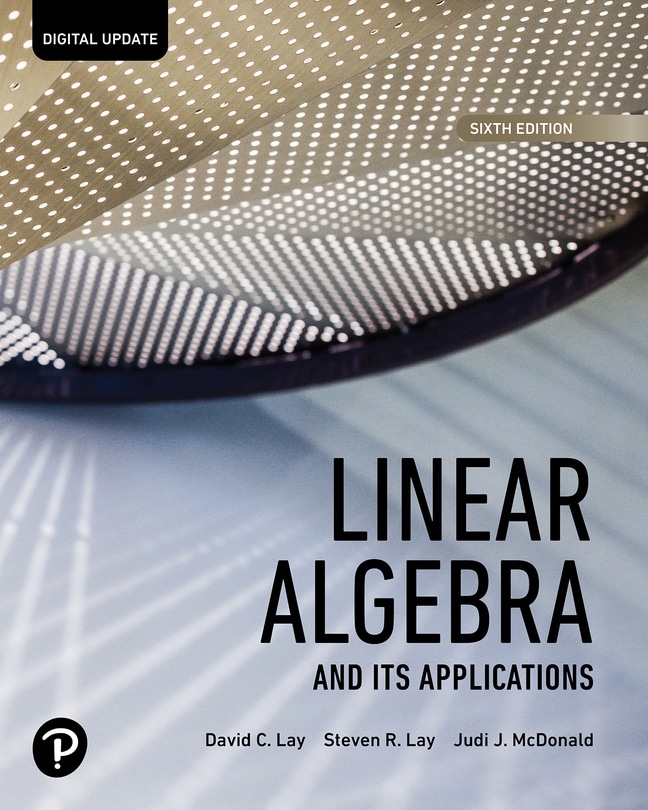
Linear Algebra and Its Applications, 6th edition
- David C. Lay
- , Judi J. McDonald
- , Steven R. Lay

- Study simpler and faster
Use flashcards and other study tools in your eTextbook
- Watch and learn
Videos & animations bring concepts to life
- Listen on the go
Learn how you like with full eTextbook audio
- Find it fast
Quickly navigate your eTextbook with search
- Stay organized
Access all your eTextbooks in one place
Linear Algebra and Its Applications is a contemporary introduction with broad, relevant applications of concepts and skills for your future career. In most linear algebra texts, the early stages of the course are relatively easy as material is presented in a familiar concrete setting, but students sometimes hit a wall when abstract concepts are introduced. Certain fundamental concepts such as linear independence, vector space and linear transformations require time to digest, and your grasp of them is essential to succeed in the course. To address this, the authors make these concepts more accessible by introducing them early in a familiar, concrete Rn setting, developing them gradually, and returning to them throughout the text so that you can understand them when they are discussed in the abstract. The 6th Edition offers new material, examples and online resources, along with new topics, vignettes and applications.
Published by Pearson (July 10th 2020) - Copyright © 2021
ISBN-13: 9780136880929
Subject: Advanced Math
Category: Linear Algebra
- Linear Equations in Linear Algebra
- Introductory Example: Linear Models in Economics and Engineering
- 1.1 Systems of Linear Equations
- 1.2 Row Reduction and Echelon Forms
- 1.3 Vector Equations
- 1.4 The Matrix Equation Ax = b
- 1.5 Solution Sets of Linear Systems
- 1.6 Applications of Linear Systems
- 1.7 Linear Independence
- 1.8 Introduction to Linear Transformations
- 1.9 The Matrix of a Linear Transformation
- 1.10 Linear Models in Business, Science, and Engineering
- Projects
- Supplementary Exercises
- Matrix Algebra
- Introductory Example: Computer Models in Aircraft Design
- 2.1 Matrix Operations
- 2.2 The Inverse of a Matrix
- 2.3 Characterizations of Invertible Matrices
- 2.4 Partitioned Matrices
- 2.5 Matrix Factorizations
- 2.6 The Leontief Input - Output Model
- 2.7 Applications to Computer Graphics
- 2.8 Subspaces of Rn
- 2.9 Dimension and Rank
- Projects
- Supplementary Exercises
- Determinants
- Introductory Example: Random Paths and Distortion
- 3.1 Introduction to Determinants
- 3.2 Properties of Determinants
- 3.3 Cramer's Rule, Volume, and Linear Transformations
- Projects
- Supplementary Exercises
- Vector Spaces
- Introductory Example: Space Flight and Control Systems
- 4.1 Vector Spaces and Subspaces
- 4.2 Null Spaces, Column Spaces, and Linear Transformations
- 4.3 Linearly Independent Sets; Bases
- 4.4 Coordinate Systems
- 4.5 The Dimension of a Vector Space
- 4.6 Change of Basis
- 4.7 Digital Signal Processing
- 4.8 Applications to Difference Equations
- Projects
- Supplementary Exercises
- Eigenvalues and Eigenvectors
- Introductory Example: Dynamical Systems and Spotted Owls
- 5.1 Eigenvectors and Eigenvalues
- 5.2 The Characteristic Equation
- 5.3 Diagonalization
- 5.4 Eigenvectors and Linear Transformations
- 5.5 Complex Eigenvalues
- 5.6 Discrete Dynamical Systems
- 5.7 Applications to Differential Equations
- 5.8 Iterative Estimates for Eigenvalues
- 5.9 Markov Chains
- Projects
- Supplementary Exercises
- Orthogonality and Least Squares
- Introductory Example: The North American Datum and GPS Navigation
- 6.1 Inner Product, Length, and Orthogonality
- 6.2 Orthogonal Sets
- 6.3 Orthogonal Projections
- 6.4 The Gram–Schmidt Process
- 6.5 Least-Squares Problems
- 6.6 Machine Learning and Linear Models
- 6.7 Inner Product Spaces
- 6.8 Applications of Inner Product Spaces
- Projects
- Supplementary Exercises
- Symmetric Matrices and Quadratic Forms
- Introductory Example: Multichannel Image Processing
- 7.1 Diagonalization of Symmetric Matrices
- 7.2 Quadratic Forms
- 7.3 Constrained Optimization
- 7.4 The Singular Value Decomposition
- 7.5 Applications to Image Processing and Statistics
- Projects
- Supplementary Exercises
- The Geometry of Vector Spaces
- Introductory Example: The Platonic Solids
- 8.1 Affine Combinations
- 8.2 Affine Independence
- 8.3 Convex Combinations
- 8.4 Hyperplanes
- 8.5 Polytopes
- 8.6 Curves and Surfaces
- Projects
- Supplementary Exercises
- Optimization
- Introductory Example: The Berlin Airlift
- 9.1 Matrix Games
- 9.2 Linear Programming - Geometric Method
- 9.3 Linear Programming - Simplex Method
- 9.4 Duality
- Projects
- Supplementary Exercises
- Finite-State Markov Chains (Online Only)
- Introductory Example: Googling Markov Chains
- 10.1 Introduction and Examples
- 10.2 The Steady-State Vector and Google's PageRank
- 10.3 Communication Classes
- 10.4 Classification of States and Periodicity
- 10.5 The Fundamental Matrix
- 10.6 Markov Chains and Baseball Statistics
Appendices
A. Uniqueness of the Reduced Echelon Form
B. Complex Numbers